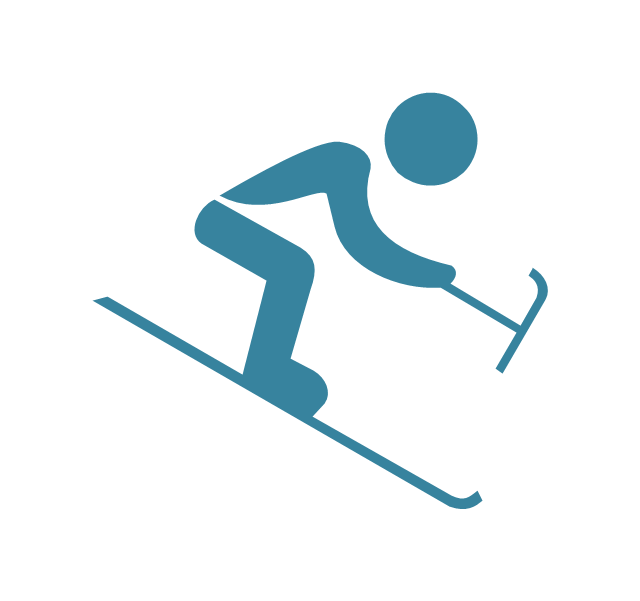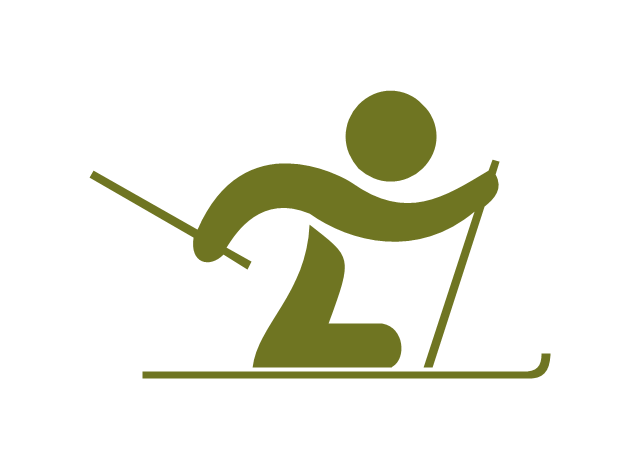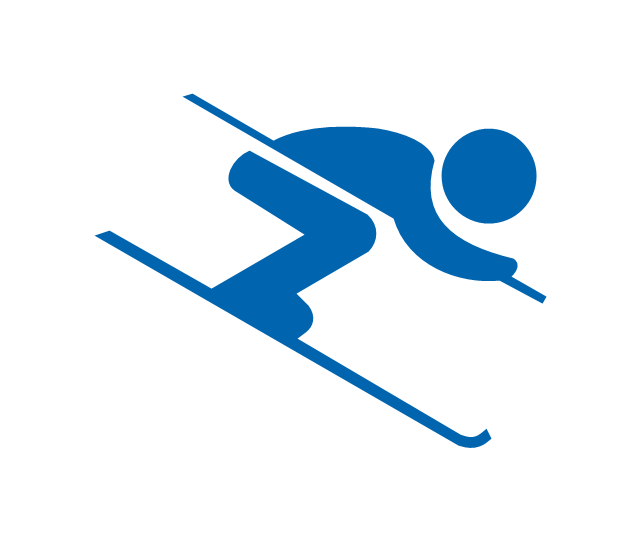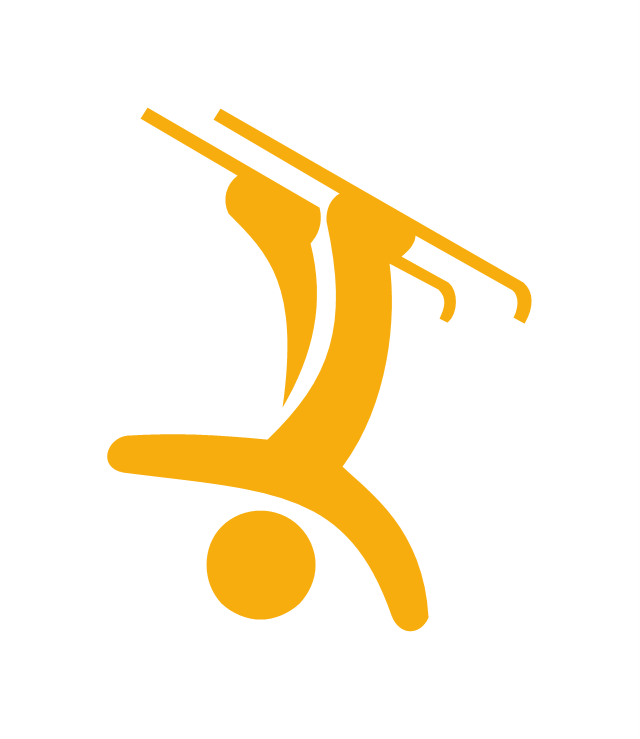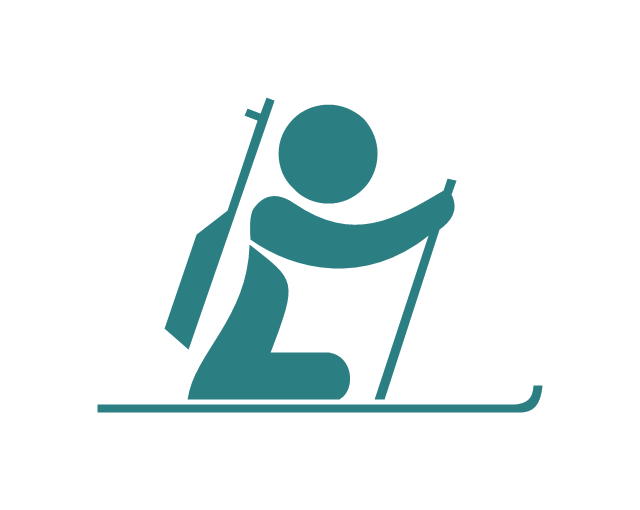"Paralympic alpine skiing is an adaptation of alpine skiing for athletes with a disability. The sport evolved from the efforts of disabled veterans in Germany and Austria during and after the Second World War. The sport is governed by the International Paralympic Committee Sports Committee. The primary equipment used includes outrigger skis, sit-skis, and mono-skis. Para-alpine skiing disciplines include the Downhill, Super-G, Giant Slalom, Slalom, Super Combined and Snowboard.
Para-alpine skiing classification is the classification system for para-alpine skiing designed to insure fair competition between alpine skiers with different types of disabilities. The classifications are grouped into three general disability types: standing, blind and sitting. A factoring system was created for para-alpine skiing to allow the three classification groupings to fairly compete against each other in the same race despite different functional skiing levels and medical issues.
Alpine skiing was one of the foundation sports at the first Winter Paralympics in 1976 with Slalom and Giant Slalom events being held. Different disciplines were added to the Paralympic programme over time. The 2010 Winter Paralympics para-alpine skiing events were held at Whistler Creekside. The disciplines at Whistler included Downhill, Super-Combined, Super-G, Slalom and Giant Slalom." [Para-alpine skiing. Wikipedia]
The vector icon example "Alpine skiing, paralympic" represents one of 20 symbols from the Winter sports pictograms library for the ConceptDraw PRO diagramming and vector drawing software.
The design elements library Winter sports pictograms is included in the Winter Sports solution from the Sport area of ConceptDraw Solution Park.
Para-alpine skiing classification is the classification system for para-alpine skiing designed to insure fair competition between alpine skiers with different types of disabilities. The classifications are grouped into three general disability types: standing, blind and sitting. A factoring system was created for para-alpine skiing to allow the three classification groupings to fairly compete against each other in the same race despite different functional skiing levels and medical issues.
Alpine skiing was one of the foundation sports at the first Winter Paralympics in 1976 with Slalom and Giant Slalom events being held. Different disciplines were added to the Paralympic programme over time. The 2010 Winter Paralympics para-alpine skiing events were held at Whistler Creekside. The disciplines at Whistler included Downhill, Super-Combined, Super-G, Slalom and Giant Slalom." [Para-alpine skiing. Wikipedia]
The vector icon example "Alpine skiing, paralympic" represents one of 20 symbols from the Winter sports pictograms library for the ConceptDraw PRO diagramming and vector drawing software.
The design elements library Winter sports pictograms is included in the Winter Sports solution from the Sport area of ConceptDraw Solution Park.
"Paralympic cross-county skiing is an adaptation of cross-country skiing for athletes with a disability. Paralympic cross-country skiing is one of two Nordic skiing disciplines in the Winter Paralympic Games. It is governed by the International Paralympic Committee. ...
Paralympic cross-country skiing includes standing events, sitting events (for wheelchair users), and events for visually impaired athletes.
The Paralympics cross-country skiing is made for skiers with disabilities. It is an adaptation of cross-country skiing, only it allows a wide variety of people who have mutations, amputations, blindness, or any other physical disability, to continue their sport. This sport appeared at the 1976 Winter Games in Örnsköldsvik, Sweden, for the first time. Depending on the competitors’ functional disability, an athlete has the option of using a sit-ski. This is a chair with a pair of skis equipped to the bottom of it. Many Sit-skiers use this because they have no use of their legs. This is called paraplegic. To ensure the safety of people with blindness, they follow a guide through the whole race. Standing skiers are skiers with a locomotive disability and who are able to use the same equipment as able-bodied skiers." [Paralympic cross-country skiing. Wikipedia]
The vector icon example "Cross-country skiing, paralympic" represents one of 20 symbols from the Winter sports pictograms library for the ConceptDraw PRO diagramming and vector drawing software.
The design elements library Winter sports pictograms is included in the Winter Sports solution from the Sport area of ConceptDraw Solution Park.
Paralympic cross-country skiing includes standing events, sitting events (for wheelchair users), and events for visually impaired athletes.
The Paralympics cross-country skiing is made for skiers with disabilities. It is an adaptation of cross-country skiing, only it allows a wide variety of people who have mutations, amputations, blindness, or any other physical disability, to continue their sport. This sport appeared at the 1976 Winter Games in Örnsköldsvik, Sweden, for the first time. Depending on the competitors’ functional disability, an athlete has the option of using a sit-ski. This is a chair with a pair of skis equipped to the bottom of it. Many Sit-skiers use this because they have no use of their legs. This is called paraplegic. To ensure the safety of people with blindness, they follow a guide through the whole race. Standing skiers are skiers with a locomotive disability and who are able to use the same equipment as able-bodied skiers." [Paralympic cross-country skiing. Wikipedia]
The vector icon example "Cross-country skiing, paralympic" represents one of 20 symbols from the Winter sports pictograms library for the ConceptDraw PRO diagramming and vector drawing software.
The design elements library Winter sports pictograms is included in the Winter Sports solution from the Sport area of ConceptDraw Solution Park.
"Alpine skiing is the sport of sliding down snow-covered hills on skis with fixed-heel bindings. It is also commonly known as downhill skiing, although that also incorporates different styles. Alpine skiing can be contrasted with skiing using free-heel bindings; ski mountaineering and nordic skiing – such as cross-country; ski jumping; and Telemark. Alpine skiing is popular wherever the combination of snow, mountain slopes, and a sufficient tourist infrastructure can be built up, including parts of Europe, North America, Australia and New Zealand, the South American Andes, and East Asia.
Alpine skiing began as a club sport 1861 at Kiandra in Australia and a number of similar clubs in North America and the Austrian and Swiss Alps. Today, most alpine skiing occurs at a ski resort with ski lifts that transport skiers up the mountain. The snow is groomed, avalanches are controlled and trees are cut to create trails. Many resorts also include snow making equipment to provide skiing when the weather would otherwise not allow it. Alternatively, alpine skiers may pursue the sport in less controlled environments; this practice is variously referred to as ski touring, backcountry skiing, or extreme skiing.
In competitive alpine skiing races four disciplines exist: slalom, giant slalom, super giant slalom, and downhill. Slalom ski races have courses that require short tight turns, whereas giant-slalom races have courses which are set with more widely spaced turns. Super-giant slalom and downhill have few turns, the courses have gates spaced widely apart and skiers often reach 100 km/ h." [Alpine skiing. Wikipedia]
The vector icon example "Alpine skiing" represents one of 20 symbols from the Winter sports pictograms library for the ConceptDraw PRO diagramming and vector drawing software.
The design elements library Winter sports pictograms is included in the Winter Sports solution from the Sport area of ConceptDraw Solution Park.
Alpine skiing began as a club sport 1861 at Kiandra in Australia and a number of similar clubs in North America and the Austrian and Swiss Alps. Today, most alpine skiing occurs at a ski resort with ski lifts that transport skiers up the mountain. The snow is groomed, avalanches are controlled and trees are cut to create trails. Many resorts also include snow making equipment to provide skiing when the weather would otherwise not allow it. Alternatively, alpine skiers may pursue the sport in less controlled environments; this practice is variously referred to as ski touring, backcountry skiing, or extreme skiing.
In competitive alpine skiing races four disciplines exist: slalom, giant slalom, super giant slalom, and downhill. Slalom ski races have courses that require short tight turns, whereas giant-slalom races have courses which are set with more widely spaced turns. Super-giant slalom and downhill have few turns, the courses have gates spaced widely apart and skiers often reach 100 km/ h." [Alpine skiing. Wikipedia]
The vector icon example "Alpine skiing" represents one of 20 symbols from the Winter sports pictograms library for the ConceptDraw PRO diagramming and vector drawing software.
The design elements library Winter sports pictograms is included in the Winter Sports solution from the Sport area of ConceptDraw Solution Park.
"Freestyle skiing is a form of skiing which originally encompassed three disciplines: aerials, moguls, and ski ballet. Today, freestyle skiing consists of aerial, moguls, skicross, boardercross, Ski half-pipe, Snowboard half-pipe and Slopestyle and have become part of the Olympics. ...
The International Ski Federation (FIS) recognized freestyle as a sport in 1979 and brought in new regulations regarding certification of athletes and jump techniques in an effort to curb the dangerous elements of the competitions. The first World Cup series was staged in 1980 and the first World Championships took place in 1986 in Tignes, France. Freestyle skiing was a demonstration event at the 1988 Winter Olympics in Calgary. Mogul skiing was added as an official medal event at the 1992 Winter Olympics in Albertville, and the aerials event was added for the 1994 Winter Olympics in Lillehammer. ...
Currently there are two main branches of freestyle skiing: one encompassing the more traditional events of moguls and aerials, and a newer branch often called new school, comprising events such as halfpipe, big air, slopestyle, and big mountain or free-skiing. Freeskiing shares characteristics with street skateboarding, BMX, and inline skating. New school skiing has grown so much that new ski companies were created, companies that strictly make twin-tip skis — skis that are designed for taking off and landing "fakie", or "switch" (backwards) on jumps and rails." [Freestyle skiing. Wikipedia]
The vector icon example "Freestyle skiing" represents one of 20 symbols from the Winter sports pictograms library for the ConceptDraw PRO diagramming and vector drawing software.
The design elements library Winter sports pictograms is included in the Winter Sports solution from the Sport area of ConceptDraw Solution Park.
The International Ski Federation (FIS) recognized freestyle as a sport in 1979 and brought in new regulations regarding certification of athletes and jump techniques in an effort to curb the dangerous elements of the competitions. The first World Cup series was staged in 1980 and the first World Championships took place in 1986 in Tignes, France. Freestyle skiing was a demonstration event at the 1988 Winter Olympics in Calgary. Mogul skiing was added as an official medal event at the 1992 Winter Olympics in Albertville, and the aerials event was added for the 1994 Winter Olympics in Lillehammer. ...
Currently there are two main branches of freestyle skiing: one encompassing the more traditional events of moguls and aerials, and a newer branch often called new school, comprising events such as halfpipe, big air, slopestyle, and big mountain or free-skiing. Freeskiing shares characteristics with street skateboarding, BMX, and inline skating. New school skiing has grown so much that new ski companies were created, companies that strictly make twin-tip skis — skis that are designed for taking off and landing "fakie", or "switch" (backwards) on jumps and rails." [Freestyle skiing. Wikipedia]
The vector icon example "Freestyle skiing" represents one of 20 symbols from the Winter sports pictograms library for the ConceptDraw PRO diagramming and vector drawing software.
The design elements library Winter sports pictograms is included in the Winter Sports solution from the Sport area of ConceptDraw Solution Park.
"Paralympic biathlon is an adaptation of biathlon for athletes with a disability. Paralympic biathlon is one of two Nordic skiing disciplines in the Winter Paralympic Games. It is governed by the International Paralympic Committee.
Paralympic biathlon includes standing events, sitting events (for wheelchair users), and events for visually impaired athletes.
Visually impaired athletes use a rifle that use sound to indicate to the athlete how accurate their aim is, and shoots a laser beam at the target." [Paralympic biathlon. Wikipedia]
The vector icon example "Biathlon, paralympic" represents one of 20 symbols from the Winter sports pictograms library for the ConceptDraw PRO diagramming and vector drawing software.
The design elements library Winter sports pictograms is included in the Winter Sports solution from the Sport area of ConceptDraw Solution Park.
Paralympic biathlon includes standing events, sitting events (for wheelchair users), and events for visually impaired athletes.
Visually impaired athletes use a rifle that use sound to indicate to the athlete how accurate their aim is, and shoots a laser beam at the target." [Paralympic biathlon. Wikipedia]
The vector icon example "Biathlon, paralympic" represents one of 20 symbols from the Winter sports pictograms library for the ConceptDraw PRO diagramming and vector drawing software.
The design elements library Winter sports pictograms is included in the Winter Sports solution from the Sport area of ConceptDraw Solution Park.
- Alpine skiing - Winter sports pictograms | Alpine skiing , paralympic ...
- Alpine skiing , paralympic - Winter sports pictograms | Winter sports ...
- Alpine skiing , paralympic - Winter sports pictograms | Biathlon ...
- Alpine skiing , paralympic - Winter sports pictograms | Snowboard ...
- Alpine skiing - Winter sports pictograms | Alpine skiing , paralympic ...
- Alpine skiing , paralympic - Winter sports pictograms | Alpine skiing ...
- Cross-country skiing , paralympic - Winter sports pictograms | Design ...
- Skeleton - Winter sports pictograms | Alpine skiing , paralympic ...
- Cross-country skiing - Winter sports pictograms | Cross-country ...
- Cross-country skiing , paralympic - Winter sports pictograms | Winter ...
- Alpine skiing , paralympic - Winter sports pictograms | Computer ...
- Speed skating - Winter sports pictograms | Cross-country skiing ...
- Winter Sports | Ski jumping - Winter sports pictograms | Speed ...
- Cross-country skiing - Winter sports pictograms | Alpine skiing ...
- Ski jumping - Winter sports pictograms | Alpine skiing - Winter sports ...
- Pictogram Symbol Freestyle Skiing Olympic
- Winter sports pictograms - Vector stencils library | Sport pictograms ...
- Ski jumping - Winter sports pictograms | Freestyle skiing - Winter ...
- Alpine skiing - Winter sports pictograms | Mountain Ski Icon
- Ski jumping - Winter sports pictograms | Design elements - Winter ...
